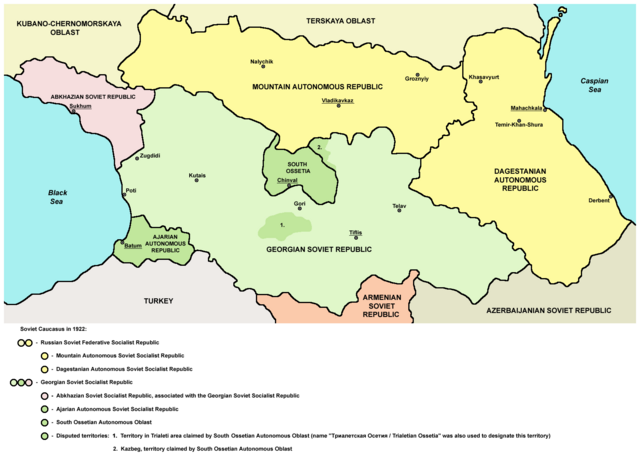Top Qs
Timeline
Chat
Perspective
South Ossetian Autonomous Oblast
Autonomous region of the Soviet Union within the Georgian SSR from 1922 to 1990 From Wikipedia, the free encyclopedia
Remove ads
The South Ossetian Autonomous Oblast (Russian: Юго-Осетинская автономная область, romanized: Yugo-Osetinskaya avtonomnaya oblast'; Georgian: სამხრეთ ოსეთის ავტონომიური ოლქი, romanized: samkhret osetis avt'onomiuri olki; Ossetian: Хуссар Ирыстоны автономон бӕстӕ, romanized: Xussar Irystony avtonomon bæstæ) was an autonomous oblast of the Soviet Union created within the Georgian SSR on April 20, 1922. It was an ethnic enclave created for the Ossetians within Georgia by Soviets as a reward for their political loyalty during the 1921 Soviet invasion of Georgia.[1] Its autonomy was revoked on December 11, 1990 by the Supreme Council of the Georgian SSR after illegally holding rival elections, leading to the First South Ossetian War. Currently, its territory is controlled by the breakaway Republic of South Ossetia.[2]
The population of the South Ossetian AO consisted mostly of ethnic Ossetians, who made up roughly 66% of the 100,000 people living there in 1989, and Georgians, who constituted a further 29% of the population as of 1989.
Remove ads
History
Summarize
Perspective
Establishment
Following the Russian revolution,[3] the area of modern South Ossetia became part of the Democratic Republic of Georgia.[4] In 1918, conflict began between the landless Ossetian peasants living in Shida Kartli (Interior Georgia), who were influenced by Bolshevism and demanded ownership of the lands they worked, and the Menshevik government backed ethnic Georgian aristocrats, who were legal owners. Although the Ossetians were initially discontented with the economic policies of the central government, the tension soon transformed into ethnic conflict.[4] The first Ossetian rebellion began February 1, 1918, when three Georgian princes were killed and their land was seized by the Ossetians. The central government of Tiflis retaliated by sending the National Guard to the area. However, the Georgian unit retreated after they had engaged the Ossetians.[5] Ossetian rebels then proceeded to occupy the town of Tskhinvali and began attacking ethnic Georgian civilian population. During uprisings in 1919 and 1920, the Ossetians were covertly supported by Soviet Russia, but even so, were defeated. Between 3,000 and 7,000 Ossetians were killed during the crushing of the 1920 uprising;[4] according to Ossetian sources ensuing hunger and epidemics were the causes of death of more than 13,000 people.
There was discussion to create a united republic for Ossetians, incorporating both North and South Ossetia. This was indeed proposed by Ossetian authorities in July 1925 to Anastas Mikoyan, the head of the kraikom (Bolshevik committee in charge of the Caucasus). Sergo Orjonikidze had opposed incorporating the proposed state into Russia, fearing it would lead to unrest in Georgia, so Mikoyan asked Stalin about placing all of Ossetia within Georgia.[6] Stalin initially approved, but later decided against it, fearing it would lead to other ethnic groups in Russia demanding to leave the RSFSR, which would destroy the federation. Thus South Ossetia was made subordinate to Georgia, while North Ossetia remained in the RSFSR.[7]
In the summer of 1944, the Soviet authorities switched to Russian and Georgian in school education, while prohibiting teaching in Ossetian. In 1949, primary classes in South Ossetian schools were also switched to Georgian and Russian. In 1951, the first secretary of the South Ossetian regional party committee, A. G. Imnadze, on behalf of the Central Committee of the Communist Party of Georgia, ordered the transfer of official documents in South Ossetia to the Georgian language.[8]
End of the South Ossetian AO
In 1989, during the dissolution of the Soviet Union, violent unrest broke out in Tskhinvali between the Georgian independence-minded population of the region and Ossetians loyal to the Soviet Union. In September 1990 Ossetian nationalists in the South Ossetia's regional soviet declared independence from Georgia by announcing "South Ossetian Soviet Democratic Republic" loyal to Moscow. After the Georgia's October elections to the Supreme Soviet, on December 11 1990, the autonomous oblast illegally held rival elections. On 12 December, gunmen driving a car in Tskhinvali opened fire from a submachine gun, killing three Georgians and wounding two in what has been described as a terrorist attack and an act of ethnic violence.[9][10] The Supreme Soviet of the Georgian SSR responded to these illegal actions by annulling the autonomy of South Ossetia and declaring the state of emergency to restore order.[11]
Remove ads
Culture and society
Summarize
Perspective

Demographics
The main ethnic group of the South Ossetian AO was the Ossetians. Throughout the entire existence of the region, the Ossetians represented a stable majority of over two-thirds of the population. Georgians constituted the only significant minority, with between 25 and 30% of the population. No other ethnic group constituted more than 3% of the total population.[12] About half of all families in the region were of mixed Ossetian–Georgian heritage.[13] Considerable numbers of Ossetians lived elsewhere in Georgia as well, with upwards of 100,000 spread across the country.[14]
Language
Most people in the South Ossetian AO spoke Ossetian, with smaller numbers using Russian and Georgian; all three were official languages of the region. Though Georgian was the language of the Georgian SSR, of which South Ossetia was part, most people in the South Ossetian AO did not speak the language; as late as 1989, only 14 per cent knew Georgian, and it was a proposal in August 1989 to make Georgian the only official language of public use that instigated the independence movement.[14] Originally written in Cyrillic, Ossetian was switched to a Latin-based script in 1923, as part of the Latinization campaign of the Soviet Union.[15] This was abandoned in 1938, with nearly every Latinized language switching to a Cyrillic script. Ossetian and Abkhaz were the only exceptions; both used a Georgian script (only in South Ossetia; North Ossetia used Cyrillic). This policy lasted until 1953 when South Ossetia abandoned the Georgian script for a Cyrillic-based one.[16]
Remove ads
See also
Notes
Bibliography
Wikiwand - on
Seamless Wikipedia browsing. On steroids.
Remove ads

